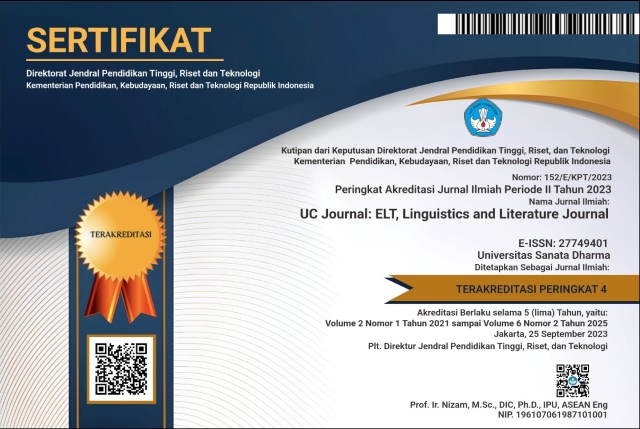CODE-SWITCHING IN SUNNYDAHYE’S INSTAGRAM CAPTIONS
(1) Sanata Dharma University
(2) Sanata Dharma University
(*) Corresponding Author
Abstract
Instagram has become one of the most used social-networking websites. In the use of communication, Instagram also provides the user to communicate through picture and video with an addition of caption to explain the media in words. To express oneself on Instagram, some users might use the combination of their first language and English. Thus the phenomena of code-switching occurs. This paper aims to analyse the type and function of code-switching used in one Instagram account, sunnydahye. This paper uses a qualitative approach to provide insights to the problems. The data for this paper is selected by using a purposive sampling method by checking sunnydahye’s Instagram post one by one. From 6 instagram posts taken as the sample, there are 22 sentences identified with a phenomena of code switching. The result of the analysis shows that the type of code-switching which is used most in sunnydahye’s Instagram caption is intra-sentential switching. Meanwhile the function of code-switching which is used most is code-switching as message qualification.
Keywords
Full Text:
PDFReferences
Argaez, E. D. (2020, March 26). Internet World Users by Language. Retrieved April 2, 2020, from Internet World Stats: https://www.internetworldstats.com/stats7.htm
Bullock, B. E., & Toribio, A. J. (Eds.). (2009). Cambridge handbooks in linguistics.The Cambridge handbook of linguistic code-switching. Cambridge University Press. https://doi.org/10.1017/CBO9780511576331
Cropley, A. J. (2019). Qualitative research methods: A practice-oriented introduction for students of psychology and education. Riga, Latvia: Zinātne. (open access – doi: 10.13140/RG.2.1.3095.6888)
Febiyaska, A. E. & Ardi, P. (2019). Indonesian-English Code-Switching in Gogirl! Magazine: Types and Features. Journal of English Language Teaching and Linguistics. 4(3). 289-303.
Gumperz, J. (1982). Discourse Strategies. Cambridge: Cambridge University Press.
Halim, N. S., & Maros, M. (2014). The Functions of Code-switching in Facebook Interactions. Procedia: Social and Behavioral Sciences, 126-133.
Holmes, J. (2008). An Introduction to Sociolinguistics (3rd ed.). London, UK: Pearson
Hudson, R. A. (1996). Sociolinguistics. Cambridge: Cambridge University Press.
Hymes, D. (1974). Foundations in Sociolinguistics: An Ethnographic Approach. Philadelphia: University of Pennsylvania Press.
Kebeya, H. (2007). Linguistic Accommodation and Code-Switching during Luo/Luyia and Luo/Gusii Contact (Unpublished dissertation). Kenyatta University, Nairobi.
Khaerunnisa, Lisa (2016). An EFL Teacher’s Code Switching in a Young Learner’s Class. Indonesian Journal of EFL and Linguistics. 1 (1). http://dx.doi.org/10.21462/ijefll.v1i1.1.
McArthur, T. (1998). Code-mixing and switching. Concise Oxford Companion to the English Language.
Myers-Scotton, Carol (1989). "Codeswitching with English: types of switching, types of communities". World Englishes. 8 (3): 333–346. doi:10.1111/j.1467-971X.1989.tb00673.x
Oco, N., & Roxas, R. E. (2012). Pattern Matching Refinements to Dictionary-Based Code-Switching Point Detection. 26th Pacific Asia Conference on Language, Information and Computation, (pp. 229-236).
Poplack, S. (1980). Sometimes I’ll start a sentence in Spanish y termino en Espanol: Toward a typology of code-switching. Linguistics. 18(7). 581-618.
Rezvani, E., & Rasekh, A. E. (2011, March). Code-switching in Iranian Elementary EFL Classrooms:. English Language Teaching, 4(1), 18-25.
Rios, J. A. (2013). Code-Switching in the EFL Classroom: Friend or Foe? Revista de Lenguas Modernas, 375-391.
Robinson, R. S. (2014). Purposive Sampling. In A. C. Michalos (Ed.), Encyclopedia of Quality of Life and Well-Being Research (p. 227). New York: Springer, Dordrecht.
Salinas, D. & Ayala, M. (2018). EFL Students-Teachers’ Identity Construction: A Case Study in Chile. HOW. 25(1). 33-49. https://doi.org/10.19183/how.25.1.380.
Shay, O. (2015). To switch or not to switch: Code-switching in a multilingual country. Procedia: Social and Behavioral Sciences, 462-469.
Song, Juyoung (2016): Language Socialization and Code-switching: A Case Study of a Korean–English Bilingual Child in a Korean Transnational Family, International Journal of Bilingual Education and Bilingualism, DOI: 10.1080/13670050.2016.1231165.
Treffers-Daller, J. (1998). The IC model and code-switching. Bilingualism: Language and Cognition, 98-99.
Wang, Wenxia (2017). Code-switching and its Role in Language Socialization, International Journal of Bilingual Education and Bilingualism, DOI: 10.1080/13670050.2017.1313809.
Yana & Nugraha, I. F. (2019). Students’ Perception on the Use of Code-Switching in English Classroom. Professional Journal of English Education. 2(2). 67-74.
Yusuf, Y. Q., et al. (2017). Types of Indonesian-English code-switching employed in a novel. Kaesetrat Journal of Social Science. 1-6. https://doi,org/10.106/j.kjss.2018.02.004.
DOI: https://doi.org/10.24071/uc.v2i1.3244
Refbacks
- There are currently no refbacks.
Copyright (c) 2021 Clara Clara, Annisa Agra Inggitajna

This work is licensed under a Creative Commons Attribution-ShareAlike 4.0 International License.
UC Journal is indexed in:
UC Journal Sinta 4 Certificate (S4 = Level 4)
We would like to inform you that UC Journal: ELT, Linguistics and Literature Journal, or UC Journal has been nationally accredited Sinta 4 by the Ministry of Education, Culture, Research and Technology of the Republic of Indonesia based on the decree No. Surat Keputusan 152/E/KPT/2023. Validity for 5 years: Vol 2 No 1, 2021 till Vol 6 No 2, 2025
DOI: https://doi.org/10.24071/uc
e-ISSN (validity starting Vol 1, No 2, November 2020): 2774-9401

This work is licensed under CC BY-SA.
Creative Commons Attribution-ShareAlike 4.0 International License
 UC Journal: ELT, Linguistics and Literature Journal, a scientific peer-reviewed journal, was established in 20 May 2020 and is published twice a year, namely in May and November, by the English Language Education Study Programme (S1/Sarjana PBI) in collaboration with the English Education Master's Programme (S2/Magister PBI) of Sanata Dharma University, Yogyakarta, Indonesia.
UC Journal: ELT, Linguistics and Literature Journal, a scientific peer-reviewed journal, was established in 20 May 2020 and is published twice a year, namely in May and November, by the English Language Education Study Programme (S1/Sarjana PBI) in collaboration with the English Education Master's Programme (S2/Magister PBI) of Sanata Dharma University, Yogyakarta, Indonesia.














